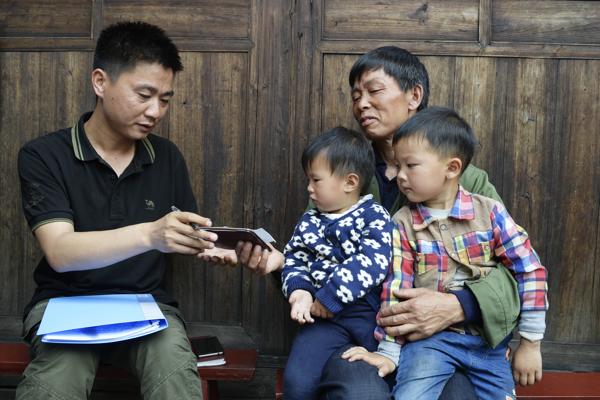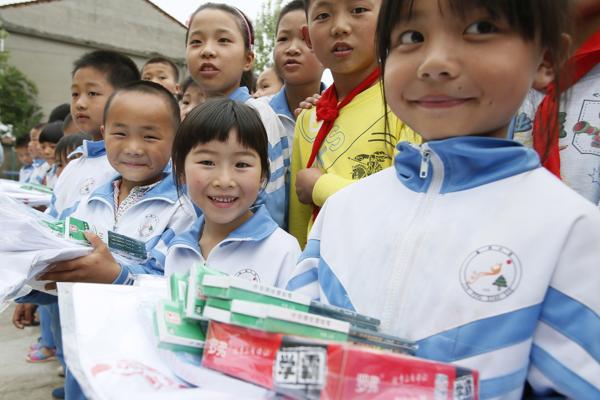
Two left-behind children follow their teacher to school in a mountainous area of Jiangxi province.[Photo by Zhuo Zhongwei/China Daily]
Late last year, Fan Juxiang made a life-changing decision. The 27-year-old migrant worker quit her job in Zhejiang province in East China, and made the 1,100-km journey home to Huarong, a village in the central province of Hunan, where she had left her 3-year-old son to be raised by his grandparents.
Before that, Fan’s life had been uneventful, and she was almost a stereotypical woman from China’s rural areas. Fan was raised as a “left-behind child”, completed a basic education, left the countryside to live in a city as a migrant worker, returned home to get married, had a child and then left home again.
“I was a left-behind girl when I was young. I understand how hard life is as a left-behind child, and I do not want my baby boy to have the same miserable childhood that I did,” she said, reflecting on her decision to return home.

Song Minghong (left), a government employee in Huarong village, Hunan province, records information about Duan Zeben’s grandsons for the country’s first national survey of left-behind children.[Photo by Xinhua and Zhu Wenbao/ China Daily]
The cost of urbanization
The authorities are hoping that other migrant workers will follow Fan’s example, and governments at all levels have created environments designed to persuade them to return to their homes so they can be with their children and earn a living.
Although China has experienced rapid industrialization and urbanization since the 1980s, the pace of change has accelerated in the last 20 years. That has led millions of rural residents to flock to large cities in search of work, leaving their underage children in the care of grandparents, relatives, or even to fend for themselves.
Now the government is carrying out the first nationwide survey of left-behind children with the aim of forming an accurate picture of their numbers nationwide to provide better support for those in need.
The latest official statistics, released by the All China Women’s Federation, show that China had about 61 million left-behind children in 2013, although the number may have been as high as 80 million, depending on the definition of a left-behind child-that is, whether one or both parents are absent.
The survey, which started in March and will finish at the end of July, is being undertaken by the ministries of civil affairs, education and public security. It will form the basis of a database that will allow arrangements to be made to ensure that the children are safe and have access to education. The results are due to be released in August.

The children of migrant workers in Hujia village, Jiangxi province, receive gifts in advance of Children’s Day, which falls on June 1.[Photo by Xinhua and Zhu Wenbao/ China Daily]
Song Minghong, a local government official in Huarong, has been collecting details about left-behind children in the village.
“It’s not a difficult job for us because we know the distribution of left-behind children in our village. We are updating existing data to include the latest changes,” Song said, adding that he usually visits about 10 families a day.
When we spoke, Song had been sitting with 59-year-old Duan Zeben for about 30 minutes, recording information about Duan’s grandchildren and cross-checking the existing information.
Duan’s son and daughter-in-law, who both work in big cities, have left their two children, ages 4 and 18 months, at home, so they fall into the main group of interest. The survey focuses on children younger than 16 whose parents are migrant workers and absent from home, or families in which one parent is a migrant worker and the other is too ill to care for the children.
The information gathered includes date of birth, sex, education, ID number, residential address, health status, and whether the children attend boarding schools. Details of the parents’ working addresses, the major source of the family’s income and the children’s registered guardians are also being collated.
“The survey is designed to help us understand the situations in which left-behind children live so we can better support those in need,” said Wang Jinhua, director of the social affairs department at the Ministry of Civil Affairs.
According to Guan Xinping, a professor of social policy at Nankai University in the northern port city of Tianjin, the survey is the first substantive step toward comprehensively providing care and protection for left-behind children.
“The survey will not only present a clear picture of the real situations of these children in different regions, but also provide a snapshot of their specific individual conditions,” he said, adding that the data will be used to guide decisions made at both the national and local level.
Devastating effects
While China’s economic development has been boosted by the influx of millions of rural migrant workers to the cities, the effects on the children they leave behind can be devastating.
“Children separated from their parents during their formative years face many problems in terms of education, security and mental health. Some left-behind children have even committed suicide or have been sexually abused. The problem should be seen as part of the wider problem of migrant workers in China,” Guan said.
A national survey conducted last year by Shangxuelushang, an NGO that helps left-behind children, showed that about 15 percent reported having no physical contact with their parents during the course of a calendar year, and 4 percent received just one phone call a year from their parents.
More tragically, a number of incidents have attracted attention to their plight. Last year in Bijie, Guizhou province, four children of absent migrant workers committed suicide at home. They were ages 5 to 13.
Also last year, a 15-year-old girl and her 13-year-old brother were murdered at their home in Bijie, while their parents were working away from home. The police found that the girl had been sexually assaulted before she was killed.
‘Is this my son?’
Fan decided to return home for good after speaking with her son via WeChat, a popular instant- and video-messaging service. She hadn’t seen the boy for several months.
“I couldn’t stop crying. I thought, ‘Is this my son? Why does he look so different?’ I missed him so much and I was in pain. I missed the precious moments of seeing him grow up,” she recalled.
Because there was no internet connection in the family home, a social worker usually arranged a mutually suitable time with Fan and her mother, then the grandmother took the boy to the community center where mother and son could speak online.
Fan found a job in the Huarong community center, earning about 1,000 yuan ($150) a month, about one-third of her salary in Zhejiang, where she worked for the online shopping platform, Taobao. She has invited other migrant workers to join a chat group on WeChat where they share local employment news and encourage people to return to their homes.
Although money is much tighter now, Fan is far happier than before. “I am no longer tortured by the separation,” she said.
Construction has now started on an industrial park in a town near Fan’s village. Liu Xiaobing, the park’s director, said the development aims to create 5,000 jobs. “We are trying to attract companies to open hubs. A Hong Kong-based cartoon company has chosen to locate their animation works here,” he said.
However, not all parents have the courage or opportunity to return home, so local governments have trialed a number of innovative ways to support their children.
About 35 percent of the students at the Jiuxijiang primary school in Xupu, a township in Hunan, are left-behind children. In recognition of their plight, the school provides treats, such as lunch with the principal, and also holds birthday parties for them.
The school has also established a “left-behind children’s home” as a center for special occasions, such as the monthly birthday parties. The center, which displays the children’s school work and essays on its walls, also has telephones and audio-video equipment that allows the children to contact their parents.
In Chuandong, a township in Guizhou province, the local government has established a community center for left-behind children and has also encouraged a local vocational school to cooperate with the center.
Support measures
“Counselors and student volunteers from the vocational school visit the community center every day to support left-behind children, sometimes with drawing and other activities,” said Yang Shuiping, head of the township.
The central government is also taking steps to address the children’s plight. A protection guideline, signed by Premier Li Keqiang, was released in February, and the Ministry of Civil Affairs set up a new section to protect vulnerable children in rural areas.
“The section will effectively link social assistance, welfare and other resources, and also work to link government departments to establish a comprehensive system to protect left-behind children,” according to a statement issued by the ministry’s department of social affairs.
While he welcomed the government’s intervention, Liu Wenkui, secretary-general of the China Foundation for the Alleviation of Poverty, said the best solution to the problem is for children to stay with their parents.
“Migrant workers should either bring their children with them to settle in cities, or the parents should support them by making a living at home in the rural areas,” Liu said.
Guan, from Nankai University, believes greater improvements in living standards and social welfare provision are urgently needed to ensure the problem is eradicated. Few migrant workers are granted hukou, or permanent resident status, in the cities in which they work, which means they and their children are always at a disadvantage compared with their urban counterparts.
“Solving the problem of the left-behind children should be linked to the protection of migrant workers’ rights and interests in urban areas. Only when city authorities allow migrant workers to become permanent urban residents and enjoy all social welfare services can the problem of left-behind children truly be solved,” he said.
